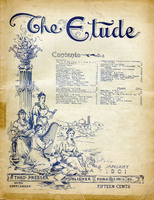PERLEE V. JERVIS.
Clearness, velocity, and brilliancy of execution, the evenness of the trill, depend more upon the up- action of the fingers, than on down. Because tone comes only on the down motion of the key, many students and teachers naturally concentrate all attention on the down-action of the finger which produces tone, and neglect the highly-important up-action, which stops the tone. Hence their playing often lacks artistic effectiveness.
Very frequently bad playing is corrected by perfecting up-motions. As soon as a good hand-position, and loose, supple, muscular conditions are established, the study of action should be commenced, and every finger in the hand should be trained to perfect equality of up- and down-action. The finger should start up as quickly as possible, by an easy, springing action; this start should be perfectly free, supple, and without any spasmodic effort. The movement of the finger in action should cause no increase of pressure upon the other fingers which remain down. The same finger should now be given a quick start down, and the instant the downward impulse is given, perfectly-loose, supple conditions should be assumed. If this be the case there will result a pure, singing tone at the piano, and later, when the fingers act in pairs, if the other necessary conditions are complied with, a pure legato will follow.



